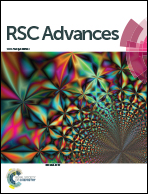One-step enzyme-free dual electrochemical immunosensor for histidine-rich protein 2 determination†
Abstract
In the present work, we describe a novel one-step enzyme-free dual electrochemical immunosensor for the determination of histidine-rich protein 2 (Ag-PfHRP2), a specific malaria biomarker. A gold electrode (GE) was functionalized with the PfHRP2 antibody (Ab-PfHRP2) using dihexadecyl phosphate (DHP) polymer as an immobilization platform. The Ab-PfHRP2/DHP/GE sensor was characterized by cyclic voltammetry, electrochemical impedance spectroscopy, Fourier-transform infrared spectroscopy, scanning electron microscopy, and atomic force microscopy. The developed immunosensor was employed for indirect Ag-PfHRP2 determination by differential pulse voltammetry (DPV) and electrochemical impedance spectroscopy (EIS). The linear range was 10–400 ng mL−1 and 10–500 ng mL−1 for EIS and DPV, while the limit of detection was 3.3 ng mL−1 and 2.8 ng mL−1, respectively. The electrochemical immunosensor was successfully applied for Ag-PfHRP2 determination in human serum samples. Its performance was compared with an ELISA test, and good correspondence was achieved. The coefficients of intra- and inter-assay variations were less than 5%. The electrochemical immunosensor is a useful and straightforward tool for in situ malaria biomarker determination.

- This article is part of the themed collections: ENQA - 20th Brazilian Meeting on Analytical Chemistry and A celebration of Latin American research in RSC Advances


 Please wait while we load your content...
Please wait while we load your content...